Carotid Artery Surgery - Open
Definition
Carotid artery surgery is a procedure to treat carotid artery disease.
The carotid artery brings needed blood to your brain and face. You have one of these arteries on each side of your neck. Blood flow in this artery can become partly or totally blocked by fatty material called plaque. This can reduce the blood supply to your brain and cause a transient ischemic attack (TIA) or stroke.
Carotid artery surgery is done to restore proper blood flow to the brain. There are two procedures to treat a carotid artery that has plaque buildup in it. This article focuses on a surgery called endarterectomy. The other method is called angioplasty with stent placement.
Alternative Names
Carotid endarterectomy; CAS surgery; Carotid artery stenosis - surgery; Endarterectomy - carotid artery
Description
During carotid endarterectomy:
- You receive general anesthesia. You are asleep and pain free. Some hospitals use local anesthesia instead. Only the part of your body being worked on is numbed with medicine so that you do not feel pain. You are also given a medicine to help you relax.
- You lie on your back on an operating table with your head turned to one side. The side your blocked carotid artery is on faces up.
- The surgeon makes a cut (incision) on your neck over your carotid artery. A flexible tube (catheter) is put in the artery. Blood flows through the catheter around the blocked area during surgery.
- Your carotid artery is opened. The surgeon removes the plaque inside the artery.
- After the plaque is removed, the artery is closed with stitches. Blood now flows through the artery to your brain.
- Your heart activity will be monitored closely during surgery.
The surgery takes about 2 hours. After the procedure, your doctor may do a test to confirm that the artery has been opened.
Why the Procedure Is Performed
This procedure is done if your doctor has found narrowing or a blockage in your carotid artery. Your health care provider will have done one or more tests to see how much the carotid artery is blocked.
Surgery to remove the buildup in your carotid artery may be done if the artery is narrowed by more than 70%.
If you have had a stroke or temporary brain injury, your provider will consider whether treating your blocked artery with surgery is safe for you.
Other treatment options your provider will discuss with you are:
- No treatment, other than tests to check your carotid artery every year.
- Medicine and diet to lower your cholesterol.
- Blood-thinning medicines to lower your risk for stroke. Some of these medicines are aspirin, clopidogrel (Plavix), dabigatran (Pradaxa), and warfarin (Coumadin).
Carotid angioplasty and stenting is likely to be used when carotid endarterectomy would not be safe.
Risks
Risks of anesthesia are:
- Allergic reactions to medicines
- Breathing problems
Risks of carotid surgery are:
- Blood clots or bleeding in the brain
- Brain damage
- Heart attack
- More blockage of the carotid artery over time
- Seizures
- Stroke
- Swelling near your airway (the tube you breathe through)
- Infection
Before the Procedure
Your provider will do a thorough physical exam and order several medical tests.
Tell your provider what medicines you are taking, even medicines, supplements, or herbs you bought without a prescription.
During the 2 weeks before your surgery:
- A few days before the surgery, you may need to stop taking blood-thinning drugs. These include aspirin, ibuprofen (Advil, Motrin), clopidogrel (Plavix), naproxen (Aleve, Naprosyn), and other drugs like these.
- Ask your provider which medicines you should still take on the day of your surgery.
- If you smoke, you need to stop. Ask your provider for help quitting.
- Tell your provider about any cold, flu, fever, herpes breakout, or other illness you may have before your surgery.
Follow instructions on when to stop eating and drinking before surgery.
On the day of your surgery:
- Take any medicines your provider prescribed with a small sip of water.
- Follow instructions on when to arrive at the hospital. Be sure to arrive on time.
After the Procedure
You may have a drain in your neck that goes into your incision. It will drain fluid that builds up in the area. It will be removed within a day.
After surgery, your provider may want you to stay in the hospital overnight so that nurses can watch you for any signs of bleeding, stroke, or poor blood flow to your brain. You may be able to go home the same day if your operation is done early in the day and you are doing well.
Follow instructions on how to take care of yourself at home.
Outlook (Prognosis)
Carotid artery surgery may help lower your chance of having a stroke. But you will need to make lifestyle changes to help prevent plaque buildup, blood clots, and other problems in your carotid arteries over time. You may need to change your diet and start an exercise program, if your provider tells you exercise is safe for you. It is also important to stop smoking.
Gallery
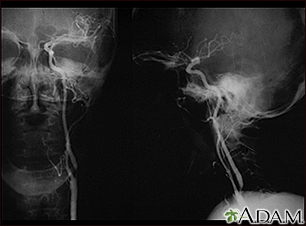
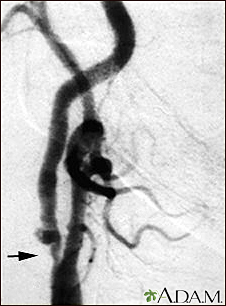
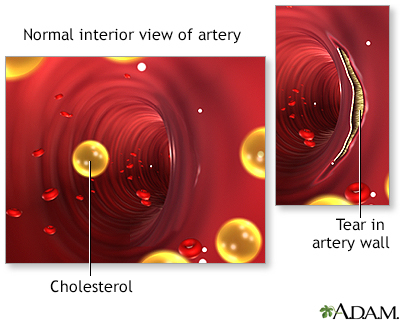
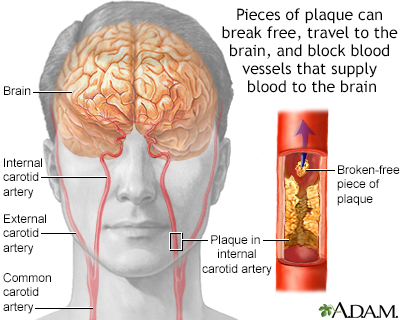
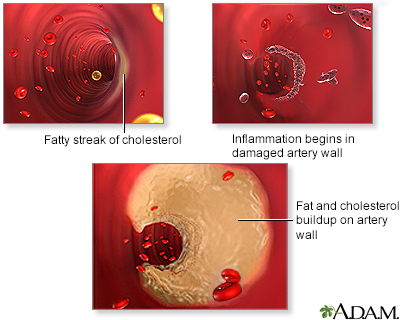
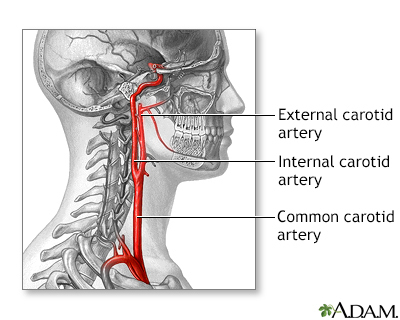
References
Arnold M, Perler BA. Carotid endarterectomy. In: Sidawy AN, Perler BA, eds. Rutherford's Vascular Surgery and Endovascular Therapy. 9th ed. Philadelphia, PA: Elsevier; 2019:chap 91.
Biller J, Schneck MJ, Ruland S. Ischemic cerebrovascular disease. In: Jankovic J, Mazziotta JC, Pomeroy SL, Newman NJ, eds. Bradley and Daroff's Neurology in Clinical Practice. 8th ed. Philadelphia, PA: Elsevier; 2022:chap 65.
Brott TG, Halperin JL, Abbara S, et al. 2011 ASA/ACCF/AHA/AANN/AANS/ACR/ASNR/CNS/SAIP/SCAI/SIR/SNIS/SVM/SVS guideline on the management of patients with extracranial carotid and vertebral artery disease: executive summary: a report of the American College of Cardiology Foundation/American Heart Association Task Force on Practice Guidelines, and the American Stroke Association, American Association of Neuroscience Nurses, American Association of Neurological Surgeons, American College of Radiology, American Society of Neuroradiology, Congress of Neurological Surgeons, Society of Atherosclerosis Imaging and Prevention, Society for Cardiovascular Angiography and Interventions, Society of Interventional Radiology, Society of NeuroInterventional Surgery, Society for Vascular Medicine, and Society for Vascular Surgery. Developed in collaboration with the American Academy of Neurology and Society of Cardiovascular Computed Tomography. Catheter Cardiovasc Interv. 2013;81(1):E76-E123. PMID: 23281092 pubmed.ncbi.nlm.nih.gov/23281092/.
Brott TG, Howard G, Roubin GS, et al. Long-term results of stenting versus endarterectomy for carotid-artery stenosis. N Engl J Med. 2016;374(11):1021-1031. PMID: 26890472 pubmed.ncbi.nlm.nih.gov/26890472/.
Holscher CM, Abularrage CJ. Carotid endarterectomy. In: Cameron AM, Cameron JL, eds. Current Surgical Therapy. 13th ed. Philadelphia, PA: Elsevier; 2020:928-933.
Related specialties
Aftercare and more
- Angioplasty and stent placement - carotid artery - discharge
- Antiplatelet drugs - P2Y12 inhibitors
- Aspirin and heart disease
- Butter, margarine, and cooking oils
- Carotid artery surgery - discharge
- Cholesterol - drug treatment
- Cholesterol and lifestyle
- Controlling your high blood pressure
- Dietary fats explained
- Fast food tips
- How to read food labels
- Mediterranean diet
- Stroke - discharge
- Surgical wound care - open
